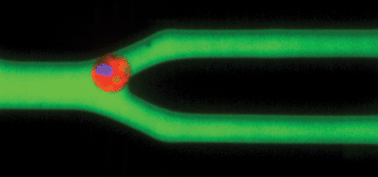Pathological processes in hematologic diseases originate at the single-cell level, often making measurements on individual cells more clinically relevant than population averages from bulk analysis. For this reason, flow cytometry has been an effective tool for single-cell analysis of properties using light scattering and fluorescence labeling. However, conventional flow cytometry cannot measure cell mechanical properties, alterations of which contribute to the pathophysiology of hematologic diseases such as sepsis, diabetic retinopathy, and sickle cell anemia. Here we present a high-throughput microfluidics-based ‘biophysical’ flow cytometry technique that measures single-cell transit times of blood cell populations passing through in vitro capillary networks. To demonstrate clinical relevance, we use this technique to characterize biophysical changes in two model disease states in which mechanical properties of cells are thought to lead to microvascular obstruction: (i) sepsis, a process in which inflammatory mediators in the bloodstream activate neutrophils and (ii) leukostasis, an often fatal and poorly understood complication of acute leukemia. Using patient samples, we show that cell transit time through and occlusion of microfluidic channels is increased for both disease states compared to control samples, and we find that mechanical heterogeneity of blood cell populations is a better predictor of microvascular obstruction than average properties. Inflammatory mediators involved in sepsis were observed to significantly affect the shape and magnitude of the neutrophil transit time population distribution. Altered properties of leukemia cell subpopulations, rather than of the population as a whole, were found to correlate with symptoms of leukostasis in patients—a new result that may be useful for guiding leukemia therapy. By treating cells with drugs that affect the cytoskeleton, we also demonstrate that their transit times could be significantly reduced. Biophysical flow cytometry offers a low-cost and high-throughput diagnostic and drug discovery platform for hematologic diseases that affect microcirculatory flow.

You have access to this article
 Please wait while we load your content...
Something went wrong. Try again?
Please wait while we load your content...
Something went wrong. Try again?


 Please wait while we load your content...
Please wait while we load your content...